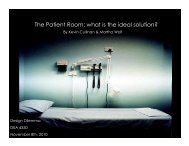The role of physical design and informal communication
The role of physical design and informal communication
The role of physical design and informal communication
Create successful ePaper yourself
Turn your PDF publications into a flip-book with our unique Google optimized e-Paper software.
formal face-to-face <strong>communication</strong> not unlike that which would occur in a meeting)<br />
because face-to-face discussion is highly valued but difficult to schedule, <strong>and</strong> any<br />
opportunity is avidly seized.<br />
1.8 Communities <strong>of</strong> Practice <strong>and</strong> Knowledge Networks<br />
<strong>The</strong> studies providing evidence <strong>of</strong> the tendency for healthcare staff to prefer<br />
<strong>informal</strong>, face-to-face conversation as a method <strong>of</strong> information seeking illustrate the<br />
communities <strong>of</strong> practice concept, which focuses on knowledge sharing across <strong>informal</strong><br />
networks <strong>of</strong> people who share a common interest or task (Lave & Wenger, 1991). For<br />
our purposes, the network <strong>of</strong> people are the nurses, doctors, technicians, etc. who<br />
<strong>informal</strong>ly share information during a spontaneous encounter at, say, the nurses station<br />
as they focus on the common interest <strong>of</strong> patient care. <strong>The</strong> communities <strong>of</strong> practice<br />
framework emerged from ethnographic analysis <strong>of</strong> how groups actually worked <strong>and</strong><br />
communicated in practice, which sharply contrasted with the work described in an<br />
organization’s manuals, training courses, <strong>and</strong> job descriptions (Brown & Duguid<br />
(1991). Horsburgh’s (1989) research confirms this notion, finding that the rhetoric<br />
<strong>and</strong> practice <strong>of</strong> the school <strong>of</strong> nursing is different from the rhetoric <strong>and</strong> practice <strong>of</strong><br />
nursing within general hospital settings, causing graduate nurses to experience<br />
difficulty in transitioning from the classroom to their first job. Duchsher (2001) found<br />
similar results concluding that graduate nurses experienced disillusionment as they<br />
faced the inconsistencies between classroom theory <strong>and</strong> practice contexts.<br />
Brown <strong>and</strong> Duguid (1991) describe the traditional perception <strong>of</strong> training as<br />
“the transmission <strong>of</strong> explicit, abstract knowledge from the head <strong>of</strong> someone who<br />
knows to the head <strong>of</strong> someone who does not in surroundings that specifically exclude<br />
the complexities <strong>of</strong> practice <strong>and</strong> the communities <strong>of</strong> practitioners.” In contrast to this<br />
14







